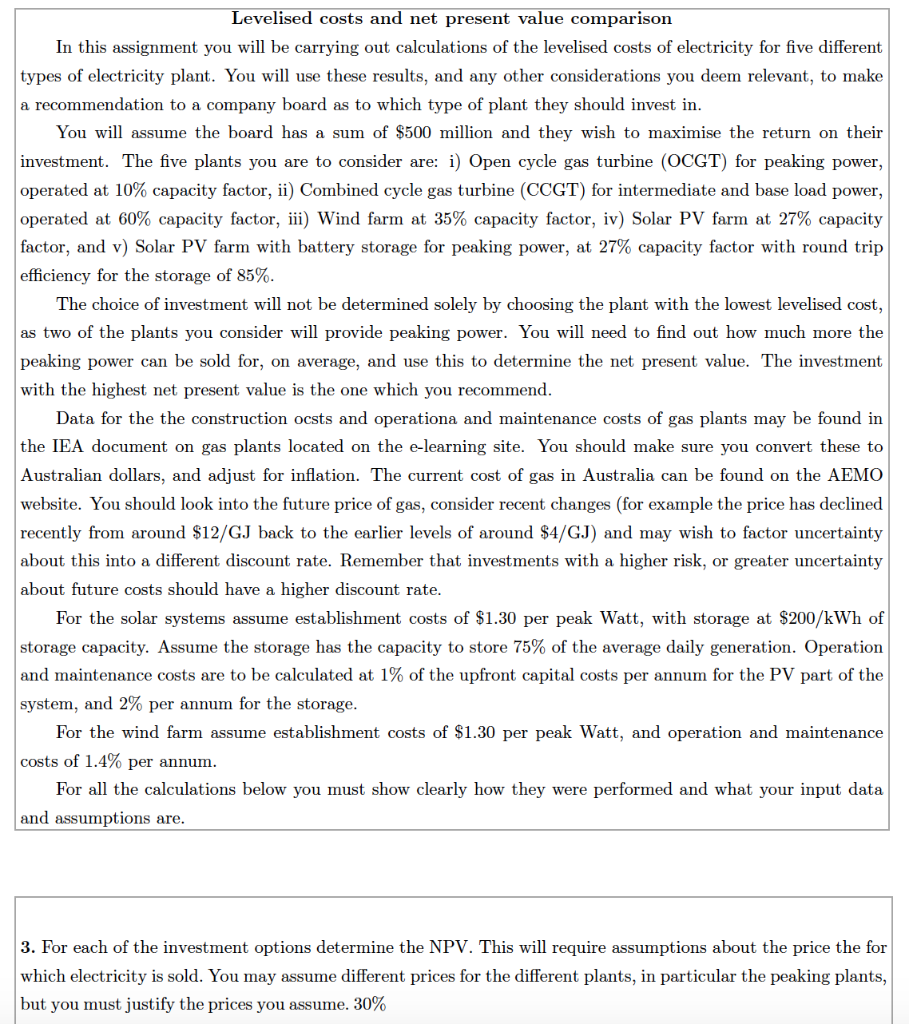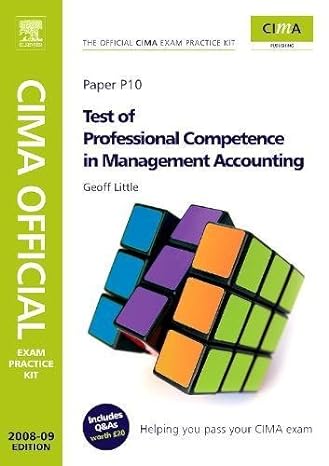
Levelised costs and net present value comparison In this assignment you will be carrying out calculations of the levelised costs of electricity for five different types of electricity plant. You will use these results, and any other considerations you deem relevant, to make a recommendation to a company board as to which type of plant they should invest in. You will assume the board has a sum of $500 million and they wish to maximise the return on their investment. The five plants you are to consider are: i) Open cycle gas turbine (OCGT) for peaking power, operated at 10% capacity factor, ii) Combined cycle gas turbine (CCGT) for intermediate and base load power, operated at 60% capacity factor, iii) Wind farm at 35% capacity factor, iv) Solar PV farm at 27% capacity factor, and v) Solar PV farm with battery storage for peaking power, at 27% capacity factor with round trip efficiency for the storage of 85%. The choice of investment will not be determined solely by choosing the plant with the lowest levelised cost, as two of the plants you consider will provide peaking power. You will need to find out how much more the peaking power can be sold for, on average, and use this to determine the net present value. The investment with the highest net present value is the one which you recommend. Data for the the construction ocsts and operationa and maintenance costs of gas plants may be found in the IEA document on gas plants located on the e-learning site. You should make sure you convert these to Australian dollars, and adjust for inflation. The current cost of gas in Australia can be found on the AEMO website. You should look into the future price of gas, consider recent changes (for example the price has declined recently from around $12/GJ back to the earlier levels of around $4/GJ) and may wish to factor uncertainty about this into a different discount rate. Remember that investments with a higher risk, or greater uncertainty about future costs should have a higher discount rate. For the solar systems assume establishment costs $1.30 per peak Watt, with storage at $200/kWh of storage capacity. Assume the storage has the capacity to store 75% of the average daily generation. Operation and maintenance costs are to be calculated at 1% of the upfront capital costs per annum for the PV part of the system, and 2% per annum for the storage. For the wind farm assume establishment costs of $1.30 per peak Watt, and operation and maintenance costs of 1.4% per annum. For all the calculations below you must show clearly how they were performed and what your input data and assumptions are. 3. For each of the investment options determine the NPV. This will require assumptions about the price the for which electricity is sold. You may assume different prices for the different plants, in particular the peaking plants, but you must justify the prices you assume. 30% Levelised costs and net present value comparison In this assignment you will be carrying out calculations of the levelised costs of electricity for five different types of electricity plant. You will use these results, and any other considerations you deem relevant, to make a recommendation to a company board as to which type of plant they should invest in. You will assume the board has a sum of $500 million and they wish to maximise the return on their investment. The five plants you are to consider are: i) Open cycle gas turbine (OCGT) for peaking power, operated at 10% capacity factor, ii) Combined cycle gas turbine (CCGT) for intermediate and base load power, operated at 60% capacity factor, iii) Wind farm at 35% capacity factor, iv) Solar PV farm at 27% capacity factor, and v) Solar PV farm with battery storage for peaking power, at 27% capacity factor with round trip efficiency for the storage of 85%. The choice of investment will not be determined solely by choosing the plant with the lowest levelised cost, as two of the plants you consider will provide peaking power. You will need to find out how much more the peaking power can be sold for, on average, and use this to determine the net present value. The investment with the highest net present value is the one which you recommend. Data for the the construction ocsts and operationa and maintenance costs of gas plants may be found in the IEA document on gas plants located on the e-learning site. You should make sure you convert these to Australian dollars, and adjust for inflation. The current cost of gas in Australia can be found on the AEMO website. You should look into the future price of gas, consider recent changes (for example the price has declined recently from around $12/GJ back to the earlier levels of around $4/GJ) and may wish to factor uncertainty about this into a different discount rate. Remember that investments with a higher risk, or greater uncertainty about future costs should have a higher discount rate. For the solar systems assume establishment costs $1.30 per peak Watt, with storage at $200/kWh of storage capacity. Assume the storage has the capacity to store 75% of the average daily generation. Operation and maintenance costs are to be calculated at 1% of the upfront capital costs per annum for the PV part of the system, and 2% per annum for the storage. For the wind farm assume establishment costs of $1.30 per peak Watt, and operation and maintenance costs of 1.4% per annum. For all the calculations below you must show clearly how they were performed and what your input data and assumptions are. 3. For each of the investment options determine the NPV. This will require assumptions about the price the for which electricity is sold. You may assume different prices for the different plants, in particular the peaking plants, but you must justify the prices you assume. 30%







